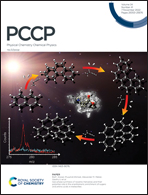Kinetic and dynamic studies of the NH2+ + H2 reaction on a high-level ab initio potential energy surface
Abstract
Gas-phase ion–molecule reactions have attracted considerable attention due to their importance in the fields of interstellar chemistry, plasma chemistry, and combustion chemistry. The reaction of an amino radical cation with a hydrogen molecule is one of the crucial steps in the gas-phase formation of ammonia in the interstellar medium (ISM). The dynamics and kinetics of the NH2+ + H2 reaction are studied using the quasi-classical trajectory approach on a newly constructed ab initio potential energy surface (PES) for the ground electronic state. The PES is fitted by the fundamental invariant-neural network method, resulting in a total root mean square error (RMSE) of 0.061 kcal mol−1. Dynamics calculations show that, on one hand, the vibrational excitation of H2 largely promotes the reaction. On the other hand, the fundamental excitation of each vibrational mode of NH2+ inhibits the reaction at low collision energies which has a negligible effect at high collision energies except for the symmetric stretching mode. The relatively higher efficacy of the symmetric stretching mode than that of the asymmetric stretching mode can be rationalized by the underlying reaction mechanisms. In addition, the calculated rate coefficients of the reaction agree reasonably well with the available experimental results.



 Please wait while we load your content...
Please wait while we load your content...